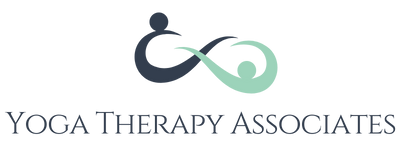By Christine Saari, MA, C-IAYT
In the landscape of posttraumatic stress disorder (PTSD) treatment, a transformative shift is underway as more individuals turn to yoga therapy as their preferred method of healing. In recent years, clinical use of yoga therapy has emerged as a groundbreaking approach that complements traditional cognitive-behavioral therapy (CBT) and cognitive processing therapy (CPT). A comprehensive study published by Zaccari et al. in December 2023 sheds light on the efficacy of a therapeutic yoga program developed by the Trauma Center in Brookline, Massachusetts called Trauma Center Trauma-Sensitive Yoga (TCTSY), marking a pivotal moment in the evolution of PTSD treatment in the field of yoga therapy1.
Understanding Yoga Therapy for PTSD
Unlike conventional therapeutic approaches that primarily engage the mind, yoga therapy recognizes the profound interconnection between the body and mind in the healing process. TCTSY is a therapeutic type of Hatha-style yoga specifically designed for individuals who have experienced trauma. It emphasizes key principles, including interoception, invitational language, choice making, non-coercion, and shared authentic experience. Yoga therapists certified by the International Association of Yoga Therapists (IAYT) who specialize in working with trauma regularly utilize the TCTSY approach as part of their toolbox when working with individual clients for trauma recovery.
The Mechanics of Yoga Therapy for PTSD
Yoga therapy for PTSD revolves around three key elements:
- Establish a felt sense of safety through safe space meditation and other body-based techniques;
- Use TCTSY techniques through use of invitational language and A-B choices to develop a sense of agency;
- Facilitate somatic reconnection by cultivating interoception.
By grounding individuals in a secure bodily space, empowering them with choice, and enhancing awareness of internal sensations, yoga therapy helps regulate the autonomic nervous system response disrupted by trauma. The emphasis on embodiment and mindfulness within yoga postures creates a personalized and effective avenue for trauma recovery.
Comparing Yoga Therapy to Traditional Therapies
The aforementioned randomized controlled trial comparing TCTSY to CPT, the current gold standard in Veterans Administration care, yielded profound results. TCTSY not only demonstrated equivalence in outcomes but also boasted a significantly higher completion rate. This is a testament to the acceptability and effectiveness of TCTSY, especially noteworthy considering the challenges associated with traditional therapies like CPT.
Challenges With Traditional Therapies for PTSD
The cognitive processing of trauma, particularly through exposure therapy, often elicits discomfort and can trigger adverse reactions such as panic attacks and nightmares. A study by Jaycox and Foa titled “Obstacles in implementing exposure therapy for PTSD: Case discussions and practical solutions” sheds light on the challenges associated with exposure techniques, emphasizing the aversions and potential drawbacks linked to re-experiencing or retelling traumatic stories2.
Moreover, exposure techniques, despite their effectiveness, frequently encounter obstacles such as extreme anger, emotional numbing, and overwhelming anxiety. The hurdles outlined in the Jaycox and Foa study resonate with the difficulties reported in implementing trauma-focused psychotherapies, including prolonged exposure and cognitive processing therapy (CPT). These evidence-based treatments lack widespread acceptability, often leading to high dropout rates and incomplete effects. Astonishingly, more than half of the individuals who complete treatment still retain their PTSD diagnosis3.
Acceptability and Compliance in Yoga Therapy for PTSD Treatment
The shift in preferences among individuals seeking PTSD treatment, driven by the observed disparity in treatment adherence and completion rates, is particularly evident among veterans. Notably, there is a substantial surge in the preference for alternative modalities, with yoga therapy emerging as a favored choice. The Veterans Administration has responded to this trend by expanding access to complementary and integrative health modalities, including yoga, underscoring a growing recognition of the importance of providing diverse and acceptable treatment options for PTSD4.
An example of the success of yoga therapy is found in TCTSY, where higher treatment initiation, retention, and completion rates compared to CPT were observed. The TCTSY group’s early and substantial symptom improvement contributed to enhanced compliance. This emphasizes that TCTSY not only matches the effectiveness of traditional therapies but is also more acceptable to participants – a pivotal factor in ensuring the success of any PTSD treatment.
Contrasting Individual Yoga Therapy, TCTSY, and Trauma-Sensitive Yoga Classes
Individual Yoga Therapy, TCTSY group yoga classes for trauma recovery, and trauma-sensitive group yoga classes represent distinct modalities in the realm of trauma recovery.
Distinguished by its personalized outcome-oriented method, individual yoga therapy customizes practices to target the specific symptoms of PTSD and individual health factors, and assigns them via a prescribed home practice. The effectiveness of yoga therapy is monitored through personalized metrics, aligning with the specific symptoms of PTSD identified by the individual as problematic for them. Yoga therapists undergo rigorous training, with over 800 hours dedicated to trauma treatment through International Association of Yoga Therapy-accredited programs and 1-2 years of professional supervision.
TCTSY, designed for group settings, offers a standardized yet evidence-based protocol for PTSD recovery, with practitioners completing a 300-hour training accredited by the Yoga Alliance. It’s important to note that the Yoga Alliance does offer accreditation for specialized yoga education; however, it does not extend accreditation to yoga therapy programs specifically intended for the treatment of medical conditions.
Also accredited by the Yoga Alliance, trauma-sensitive yoga training can be completed in as little as 25 hours, focusing primarily on training yoga teachers to enhance an awareness of the impact of trauma and to avoid common triggers, such as hands-on assists and coercive cuing, within group yoga settings.
While each modality addresses trauma, the depth of training and the degree of personalization vary, providing individuals with a suite of options to suit their unique needs in the journey towards healing.
A Paradigm Shift in PTSD Treatment
For those seeking PTSD treatment, a shift is occurring as people increasingly explore alternatives to conventional talk therapies and exposure techniques. Yoga therapy is gaining prominence in this evolving paradigm, offering a holistic approach that addresses the understanding that trauma is experienced by the body first.
Within the field of yoga therapy, TCTSY stands out as an embodiment-focused methodology frequently utilized by yoga therapists in their work with individual clients. This approach not only solidifies its reputation as an effective and acceptable treatment, but also plays a pivotal role in reshaping how PTSD is approached, emphasizing the essential role of the body in the healing process. This marks a significant departure from traditional therapeutic methods, highlighting the growing influence of embodied approaches in trauma recovery.
Wider Accessibility and Cost-Effectiveness
While the accessibility of yoga therapy has traditionally been limited by its lack of insurance coverage, a positive development is occurring. In some states, yoga therapy is now fully reimbursable through various Victim Compensation Program funds, expanding its reach to a more diverse population.
This development holds particular significance given the rising costs associated with untreated or unresolved PTSD. The cost-effectiveness of yoga therapy, especially when utilizing a TCTSY approach, emerges as a significant advantage, potentially relieving the economic burden linked to PTSD. Notably, the military and Veterans Affairs departments are increasingly exploring the implementation of yoga therapy programs to support individuals who have experienced job-related trauma and are currently on disability, aiming to facilitate their return to the workforce. Ultimately, these initiatives underscore that investing in yoga therapy can be a cost-effective strategy at an institutional level, promoting holistic healing and recovery.
For insights into the transformative impact of yoga therapy on a law enforcement officer’s recovery, and to learn how he overcame the stigma associated with practicing yoga, watch this testimonial from Yoga Therapy Associates.
Conclusion
As we explore the ever-evolving field of PTSD treatment, yoga therapy emerges as a preferred and transformative approach with untapped economic potential. Backed by scientific evidence and a growing body of acceptance, yoga therapy is not just an alternative, but a promising option for those seeking a holistic, body-centered path to healing from trauma. The study’s outcomes underscore the effectiveness, acceptability, and accessibility of TCTSY, marking a new era in the treatment of PTSD where yoga therapy stands tall among the most preferred approaches.
Yoga Therapy Associates provides yoga therapy services nationwide via telehealth. Contact us to learn more about how yoga therapy can help you with trauma recovery and to explore our commitment to developing institutional partnerships promoting accessibility of these services.
References
- Zaccari, B., Higgins, M., Haywood, T. N., Patel, M., Emerson, D., Hubbard, K., Loftis, J. M., & Kelly, U. A. (2023). Yoga vs Cognitive Processing Therapy for Military Sexual Trauma–Related Posttraumatic Stress Disorder: A Randomized Clinical Trial. JAMA Network Open, 6(12), e2344862. https://doi.org/10.1001/jamanetworkopen.2023.44862
- Jaycox, L. & Foa, E. (1996). Obstacles in implementing exposure therapy for PTSD: Case discussions and practical solutions. Clinical psychology & psychotherapy, 3(3), 176-184. https://doi.org/10.1002/(SICI)1099-0879(199609)3:3<176::AID-CPP100>3.0.CO;2-1
- Zaccari, B., Higgins, M., Haywood, T. N., Patel, M., Emerson, D., Hubbard, K., Loftis, J. M., & Kelly, U. A. (2023). Yoga vs Cognitive Processing Therapy for Military Sexual Trauma–Related Posttraumatic Stress Disorder: A Randomized Clinical Trial. JAMA Network Open, 6(12), 14-16. https://doi.org/10.1001/jamanetworkopen.2023.44862
- Zaccari, B., Higgins, M., Haywood, T. N., Patel, M., Emerson, D., Hubbard, K., Loftis, J. M., & Kelly, U. A. (2023). Yoga vs Cognitive Processing Therapy for Military Sexual Trauma–Related Posttraumatic Stress Disorder: A Randomized Clinical Trial. JAMA Network Open, 6(12), 17. https://doi.org/10.1001/jamanetworkopen.2023.44862




